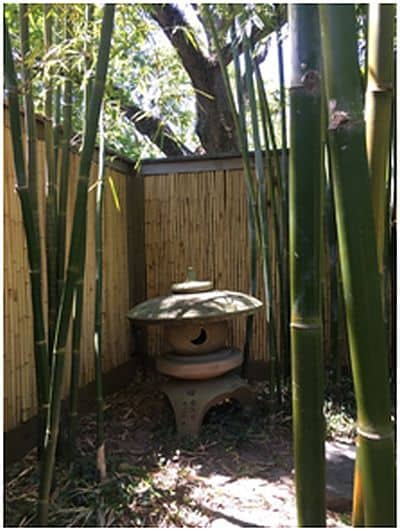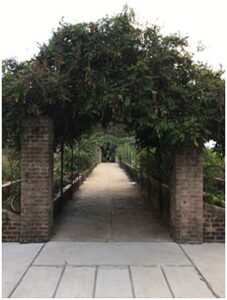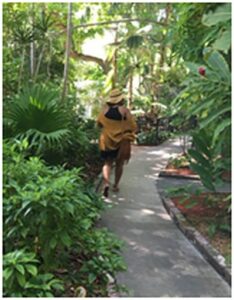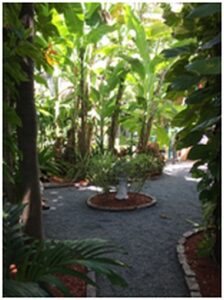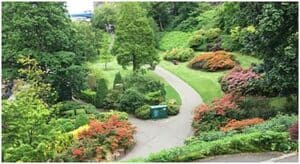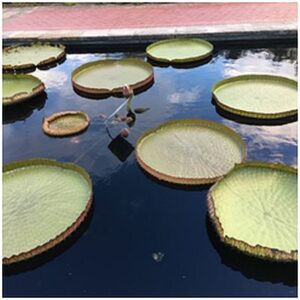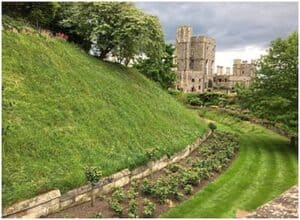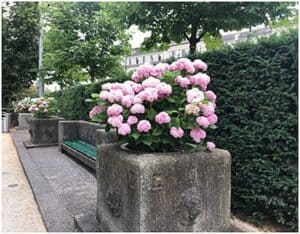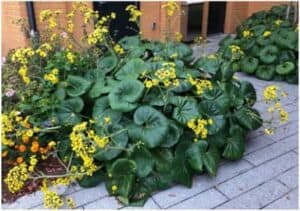(Image above: Vertical lines of Bamboo and fence lead the eye up)
Elements of Design for an Exciting Landscape (Line, Form, Color and Texture)
Elements of design composition are the visual qualities that people see and respond to when viewing a garden space. Visual qualities can illicit many different emotions and feelings, and the more positive those feelings, the more likely people are to enjoy and use a space.
Line in the landscape is created by the edge between two materials, the outline or silhouette of a form, or a long linear feature. Lines can be used to create shapes and forms. They control movement of the eye and the body. Landscape designers use lines to establish dominance and create a cohesive theme in a landscape.
(Images above: [left] Vertical and Horizontal lines lead you beyond; [center] Curved paths slow movement; [right] Circular planting in middle slow movement even more)
Vertical lines move the eye up, making a space feel larger. An upward line can emphasize a feature and has a feeling of activity or movement. Vertical lines in the landscape include tall, narrow plant material, such as trees, or tall structures, such as an arbor or a bird house on a pole.
(Images left: [top] Example of various forms, circular, columnar shapes; [center] Circles of water lily foliage and horizontal lines of walkway; [bottom]Curved landscape, patterned lawn leads to the palace)
Horizontal lines move the eyes low along the ground and make area or space feel bigger. Edging, buildings, walls and low shrubs can help create horizontal lines.
Curved lines create an informal, natural, relaxed character that is associated more with nature and asymmetrical balance. Curved lines move the eye at a slower pace and add mystery to the space by creating hidden views.
Form or Shape is created by an outline that encloses a space, and form is the three-dimensional mass of that shape. Form is found in both hardscape and plants, and it is typically the dominant visual element that spatially organizes the landscape and often determines the style of the garden. The form of structures, plant beds, and garden ornaments also determines the overall form theme of the garden. Formal, geometric forms include circles, squares, and polygons. Informal, naturalistic forms include meandering lines, organic edges, and fragmented edges. Plants create form in the garden through their outlines or silhouettes. Form can also be defined by a void or negative space between plants.
Color in plant material and hardscape adds interest and variety to the landscape. Color is the most conspicuous element in the landscape and is usually the focus of most homeowners. Colors have properties that can affect emotions, spatial perception, light quality, balance, and emphasis. Cool colors tend to be calming and should be used in areas for relaxation and serenity. Warm colors tend to be more exciting and should be used in areas for entertaining and parties. Cool colors tend to recede and are perceived as being farther away, making a space feel larger. Warm colors tend to advance and are perceived as being closer, making a space feel smaller. Color can also be used to capture attention and direct views. Focal points can be created with bright colors. Color should be used to highlight more enduring elements, such as texture and form.
Texture refers to how coarse or fine the surface of the plant or hardscape material feels and/or looks. Texture is used to provide variety, interest, and contrast. The plant’s foliage, flowers, bark, and overall branching pattern all have texture. The size and shape of the leaves often determines the texture of the plant. A plant can be described as having coarse, medium, or fine texture. Coarse-textured plants attract the eye and tend to hold it because the light and dark contrasts of the shadows provide more interest. Fine texture exaggerates distance and gives the feeling of a larger, more open space. Rough texture plants appear closer, and the space feels smaller, or enclosed. Texture is found in hardscape (buildings, patios, walls, and walkways).
(Images above: [left] Color of Hydrangea used as a focal point of interest and to highlight texture and form; [right] Leaves of Ligularia and stone walkway both provide texture)
*Most Information for this article taken from article by Gail Hansen, IFAS Extension, University of Florida. Also inspired by presentation from Damon Abdi, PhD, Assistant Professor, LSU AgCenter, Hammond Research Center. All pictures by K. Blackburn, MGGNO.

By Karen Blackburn

